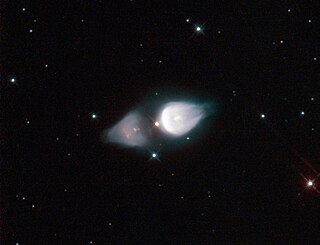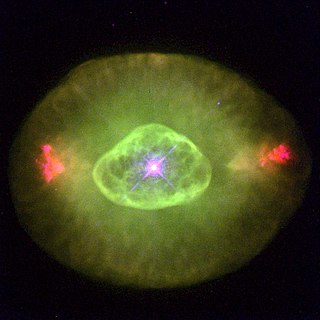
A nebula is a distinct luminescent part of interstellar medium, which can consist of ionized, neutral, or molecular hydrogen and also cosmic dust. Nebulae are often star-forming regions, such as in the Pillars of Creation in the Eagle Nebula. In these regions, the formations of gas, dust, and other materials "clump" together to form denser regions, which attract further matter and eventually become dense enough to form stars. The remaining material is then thought to form planets and other planetary system objects.

A planetary nebula is a type of emission nebula consisting of an expanding, glowing shell of ionized gas ejected from red giant stars late in their lives.

The Ring Nebula is a planetary nebula in the northern constellation of Lyra.[C] Such a nebula is formed when a star, during the last stages of its evolution before becoming a white dwarf, expels a vast luminous envelope of ionized gas into the surrounding interstellar space.

The Orion Nebula is a diffuse nebula situated in the Milky Way, being south of Orion's Belt in the constellation of Orion,[b] and is known as the middle "star" in the "sword" of Orion. It is one of the brightest nebulae and is visible to the naked eye in the night sky with an apparent magnitude of 4.0. It is 1,344 ± 20 light-years (412.1 ± 6.1 pc) away and is the closest region of massive star formation to Earth. The M42 nebula is estimated to be 24 light-years across. It has a mass of about 2,000 times that of the Sun. Older texts frequently refer to the Orion Nebula as the Great Nebula in Orion or the Great Orion Nebula.

The Cat's Eye Nebula is a planetary nebula in the northern constellation of Draco, discovered by William Herschel on February 15, 1786. It was the first planetary nebula whose spectrum was investigated by the English amateur astronomer William Huggins, demonstrating that planetary nebulae were gaseous and not stellar in nature. Structurally, the object has had high-resolution images by the Hubble Space Telescope revealing knots, jets, bubbles and complex arcs, being illuminated by the central hot planetary nebula nucleus (PNN). It is a well-studied object that has been observed from radio to X-ray wavelengths.

The Calabash Nebula, also known as the Rotten Egg Nebula or by its technical name OH 231.84 +4.22, is a protoplanetary nebula (PPN) 1.4 light years long and located some 5,000 light years from Earth in the constellation Puppis. The name "Calabash Nebula" was first proposed in 1989 in an early paper on its expected nebular dynamics, based on the nebula's appearance. The Calabash is almost certainly a member of the open cluster Messier 46, as it has the same distance, radial velocity, and proper motion. The central star is QX Puppis, a binary composed of a very cool Mira variable and an A-type main-sequence star.

The Stingray Nebula is the youngest-known planetary nebula, having appeared in the 1980s. The nebula is located in the direction of the southern constellation Ara, and is located 18,000 light-years away. Although it is some 130 times the size of the Solar System, the Stingray Nebula is only about one tenth the size of most other known planetary nebulae. The central star of the nebula is the fast-evolving star SAO 244567. Until the early 1970s, it was observed on Earth as a preplanetary nebula in which the gas had not yet become hot and ionized.

The Saturn Nebula is a planetary nebula in the constellation Aquarius. It appears as a greenish-yellowish hue in a small amateur telescope. It was discovered by William Herschel on September 7, 1782, using a telescope of his own design in the garden at his home in Datchet, England, and was one of his earliest discoveries in his sky survey. The nebula was originally a low-mass star that ejected its layers into space, forming the nebula. The central star is now a bright white dwarf star of apparent magnitude 11.5. The Saturn Nebula gets its name from its superficial resemblance to the planet Saturn with its rings nearly edge-on to the observer. It was so named by Lord Rosse in the 1840s, when telescopes had improved to the point that its Saturn-like shape could be discerned. William Henry Smyth said that the Saturn Nebula was one of Struve's nine "Rare Celestial Objects".

The Egg Nebula is a bipolar protoplanetary nebula approximately 3,000 light-years away from Earth. Its peculiar properties were first described in 1975 using data from the 11 μm survey obtained with sounding rocket by Air Force Geophysical Laboratory (AFGL) in 1971 to 1974.

NGC 7027, also known as the Jewel Bug Nebula or the Magic Carpet Nebula, is a very young and dense planetary nebula located around 3,000 light-years from Earth in the constellation Cygnus. Discovered in 1878 by Édouard Stephan using the 800 mm (31 in) reflector at Marseille Observatory, it is one of the smallest planetary nebulae and by far the most extensively studied.

A protoplanetary nebula or preplanetary nebula is an astronomical object which is at the short-lived episode during a star's rapid evolution between the late asymptotic giant branch (LAGB)[a] phase and the subsequent planetary nebula (PN) phase. A PPN emits strongly in infrared radiation, and is a kind of reflection nebula. It is the second-from-the-last high-luminosity evolution phase in the life cycle of intermediate-mass stars.

M1-92, also known as Minkowski’s Footprint or the Footprint Nebula, is a bipolar protoplanetary nebula in the constellation of Cygnus. It is a type of reflection nebula, visible only by light reflected from the central star. The central star is not yet a white dwarf but is quickly becoming one. In a few thousand years the star will be hot enough to emit vast quantities of ultraviolet radiation that will ionize the nebula surrounding it, making it a fully fledged planetary nebula.

NGC 246 is a planetary nebula in the constellation Cetus. It is the first known planetary nebula to have a hierarchical triple star system at its center. The nebula and the stars associated with it are listed in several catalogs, as summarized by the SIMBAD database. NGC 246 was discovered by William Herschel in 1785.

A bipolar outflow comprises two continuous flows of gas from the poles of a star. Bipolar outflows may be associated with protostars, or with evolved post-AGB stars.

The Frosty Leo Nebula is a protoplanetary nebula (PPN) located roughly at 3000 light-years away from Earth in the direction of the constellation Leo. It is a spectral bipolar nebula. Its central star is of optical spectral type K7II, by itself called Frosty Leo. It is unusual in that it has an extremely deep absorption feature at 3.1 μm and is unusually located at more than 900 pc above the plane of our galaxy.(Bourke et al. 2000) Further, as of 1990, it has the only known PPN circumstellar outflow in which crystalline ice dominates the long-wavelength emission spectrum and the only known PPN with point-reflection-symmetric deviations from axial symmetry.

NGC 6826 is a planetary nebula located in the constellation Cygnus. It is commonly referred to as the "Blinking Planetary", although many other nebulae exhibit such "blinking". When viewed through a small telescope, the brightness of the central star overwhelms the eye when viewed directly, obscuring the surrounding nebula. However, it can be viewed well using averted vision, which causes it to "blink" in and out of view as the observer's eye wanders.

NGC 2899 is a planetary nebula in the southern constellation of Vela. It was discovered by English astronomer John Herschel on February 27, 1835. This nebula can be viewed with a moderate-sized amateur telescope, but requires a larger telescope to resolve details. NGC 2899 is located at a distance of 3,350 ± 670 light-years (1,026 ± 205 pc) from the Sun and 25,894 ± 3 light-years (7,939 ± 1 pc) from the Galactic Center.

IRAS 19475+3119 is a protoplanetary nebula in the constellation of Cygnus, 15,000 light-years away. The central star, V2513 Cygni, is an F-type post-AGB star.

NGC 6778 is a planetary nebula (PN) located about 10,300 light years away from the Sun in the equatorial constellation of Aquila. It is positioned 5° to the SSW of the prominent star Delta Aquilae. This nebula was discovered by German astronomer Albert Marth during the period 1863–1865. English astronomer John Herschel may have mistakenly catalogued it as NGC 6785, as nothing can be found now at the coordinates he gave for it. In the New General Catalogue it was described as a "small, elongated, ill-defined disc".

IRAS 22036+5306, also known as 2MASS J22053028+5321327, is a protoplanetary nebula located in the constellation Cepheus at approximately ~6,500 light-years from Earth.




















